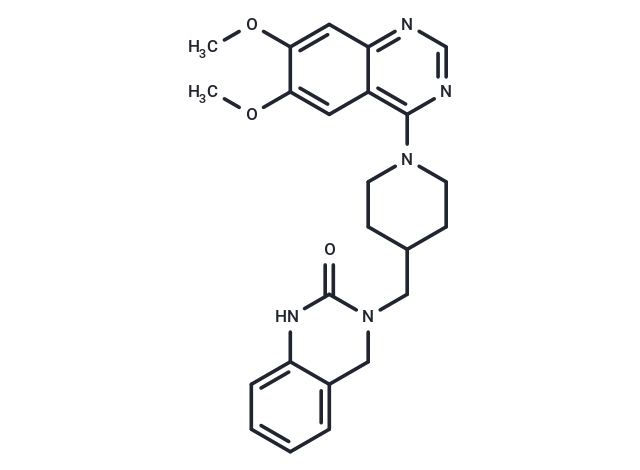Shopping Cart
- Remove All
 Your shopping cart is currently empty
Your shopping cart is currently empty

K-756 is a direct and selective inhibitor of tankyrase (TNKS), inhibiting the ADP-ribosylation activity of TNKS1 [IC50 = 31 nM] and TNKS2 [IC50 = 36 nM].

| Pack Size | Price | Availability | Quantity |
|---|---|---|---|
| 1 mg | $44 | In Stock | |
| 5 mg | $97 | In Stock | |
| 10 mg | $172 | In Stock | |
| 25 mg | $333 | In Stock | |
| 50 mg | $597 | In Stock | |
| 100 mg | $852 | In Stock | |
| 500 mg | $1,730 | In Stock | |
| 1 mL x 10 mM (in DMSO) | $116 | In Stock |
| Description | K-756 is a direct and selective inhibitor of tankyrase (TNKS), inhibiting the ADP-ribosylation activity of TNKS1 [IC50 = 31 nM] and TNKS2 [IC50 = 36 nM]. |
| Targets&IC50 | TNKS1:31 nM, TNKS2:36 nM |
| In vitro | K-756 inhibits the cell growth of APC-mutant colorectal cancer COLO 320DM and SW403 cells by inhibiting the Wnt/β-catenin pathway. K-756 is a novel and selective Wnt/β-catenin pathway inhibitor targeting tankyrase (TNKS). TNKS is one of the members of the PARP family. K-756 binds to the induced pocket of TNKS and inhibits its enzyme activity. K-756 inhibits TNKS1 and TNKS2 by 97% and 100%, respectively. The inhibitory activity of K-756 against PARP1, PARP2, PARP3, PARP6, PARP7, and PARP11 is less than 13%. K-756 strongly inhibits the reporter activity in DLD-1/TCF-Luc cells (IC50: 110 nM) but does not inhibit DLD-1/mtTCF-Luc cells, even at 1,000 nM. APC-mutant colorectal cancer cell line COLO 320DM and SW403 cells are treated with K-756 and after 144 hours, cell growth inhibition is measured by an XTT assay. The application of K-756 inhibits the cell growth of COLO 320DM with a GI50 of 780 nM. K-756 also inhibits SW403 with a GI50 of 270 nM[1]. |
| In vivo | Vehicle (0.5% MC400) or K-756 is given orally once daily for three consecutive days at doses of 100, 200, and 400 mg/kg. The inhibition of the Wnt/β-catenin pathway in tumors is assessed by measuring the levels of FGF20 and LGR5, as well as luciferase activity. Inhibition of the Wnt/β-catenin pathway is evident at a 400 mg/kg dose after just one day of administration. After three days of treatment, significant reductions in FGF20 expression and reporter activity are observed at doses of 100 mg/kg and higher, while LGR5 expression significantly decreases at doses of 200 mg/kg and higher. The greatest inhibitory effect is achieved with a three-day administration of K-756 at 400 mg/kg [1]. |
| Molecular Weight | 433.5 |
| Formula | C24H27N5O3 |
| Cas No. | 130017-40-2 |
| Smiles | COc1cc2ncnc(N3CCC(CN4Cc5ccccc5NC4=O)CC3)c2cc1OC |
| Relative Density. | 1.261 g/cm3 (Predicted) |
| Storage | Powder: -20°C for 3 years | In solvent: -80°C for 1 year | Shipping with blue ice. | ||||||||||||||||||||
| Solubility Information | DMSO: 4.5 mg/mL (10.38 mM), Sonication is recommended. | ||||||||||||||||||||
Solution Preparation Table | |||||||||||||||||||||
DMSO
| |||||||||||||||||||||

Copyright © 2015-2024 TargetMol Chemicals Inc. All Rights Reserved.